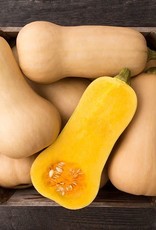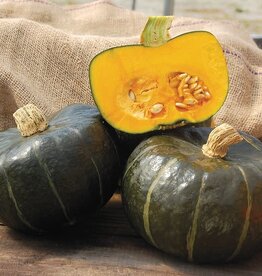HM Waltham Butternut Squash 1/8 OZ
| Availability: | In stock (9) |
Photo and Description Credit - High Mowing Seeds
By far the most widely grown open-pollinated butternut with delicious, finely textured dark orange flesh.
Uniform fruits with smooth, tan skin that is easily peeled with a potato peeler. Our strain has been selected for uniformity of size, shape and yields. Excellent keeper if cured properly.
- Stores well
- Vining
- Uniform, 4-5 lbs
Acorn and Butternut- 280-375 seeds/oz (312 avg), 4,500-6,000 seeds/lb (5,000 avg); Buttercup and Spaghetti- 135-200 seeds/oz (155 avg), 2,200-3,200 seeds/lb (2,500 avg); Hubbard- 90-125 seeds/oz (105 avg), 1,500-2,000 seeds/lb (1,700 avg); Delicata/Dumpling- 425-590 seeds/oz (470 avg), 6,800-9,500 (7
Cultural Info
Winter squashes (Cucurbita spp.) are warm season tender annuals in the Cucurbitaceae family, which includes cucumbers, summer squash, melons, and gourds.
Soil Nutrients and Requirements
Plants need loose, fertile, well drained soil with plenty of organic matter and nitrogen and a pH 5.8-6.8. Fertilize seedlings with fish emulsion if leaves yellow.
Seeding Depth
½-1”
Plant Spacing
Plant spacing: for bush varieties 18-24”, for vining 24-36”
Row Spacing
Row spacing: for bush, semi-bush and short vine types is 6’, for vigorous vining types use 9’. Plants can also be planted in hills of 3-5 plants in rows 3-5’ apart (bush types provide less weed suppression so are typically planted closer than vining types) for easier tractor cultivation.
When to Sow
Days to maturity are from direct seeding, subtract 2 weeks if transplanting. Winter squash has a long season, requiring 90-120 frost free days to reach maturity, so it is usually transplanted in northern climates. It can also be direct seeded once danger of frost has passed and soil temperatures reach 70°F. Start transplants indoors 3-4 weeks before last risk of frost. Optimal soil temperature for germination is 85-95°F.
Other Considerations
Black plastic mulch can be used to increase soil temperature for earlier planting.
Harvest
Harvest when fruits are full size and have a deep rich color and hard rinds that can’t be easily dented with a finger nail. Changing color of the “ground spot” from yellow to cream, gold or orange is another general indicator of ripeness. To harvest, cut stem at least 2” from the fruit: a short or broken stem can lead to rot. Cure after harvest by keeping in a warm, dry location for a few days then
Storage
Store at 50-55°F with 55-75% relative humidity and good air circulation. Delicata and acorn squash do not need curing, but will not store as long as other varieties.
Pest Info
- Striped Cucumber beetle feeding can damage young leaves so extensively that plants either die or are stunted in growth. Dipping or spraying seedlings with kaolin clay can significantly deter infestations. Combine clay with insecticidal soap (such as Safer Brand™, see Supplies) or neem (such as Ahimsa Neem Oil). Use of a trap crop preferred by cucumber beetles, such as blue hubbard squash, lures beetles away from main crop. Crop rotation, removal of crop debris to discourage overwintering populations, and use of floating row cover can be effective in controlling cucumber beetles.
- Squash vine borer will cause plants to look wilted even when moisture is plentiful. Slice open stem and remove and destroy.
- Squash bugs can be controlled by handpicking. Bury or compost plant residues at the end of the season.
Disease Info
- Powdery mildew can be checked by providing good air circulation. Give plants wide spacing and eliminate weeds, especially milkweed, marshcress and yellowrocket. Choose resistant varieties.
- Fruit rots such as anthracnose, scab, and fusarium fruit rot are common under wet conditions. Space plants apart, avoid wetting foliage and water early in the day so that leaves can dry.
- Fusarium Wilt is caused by the fungus Fusarium oxysporum f. sp. Melonis (Fom), and can be seed and/or soil borne.
- Bacterial Wilt and Cucumber mosaic virus should be controlled by removing and destroying infected plants.




